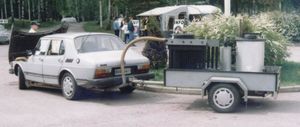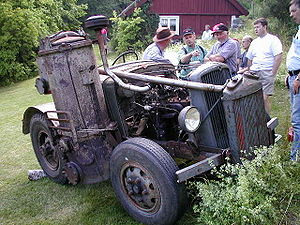Wood gas generator
A wood gas generator often known as a gasifier, is a wood-fueled gasification reactor mounted on an internal combustion engine, to provide a wood gas, a form of syngas. These devices are also known as gas producers.
Contents
[hide]History
Gasification was an important and familiar 19th and early 20th century technology, and its potential and practical applicability to internal combustion engines were well-understood from the earliest days of their development. Town gas was produced from coal as a local business, mainly for lighting purposes, at least initially, and experience in the trade was widespread; most practicing technical people would know a good deal about it. When stationary internal combustion engines based on the Otto cycle became available (and especially after the Otto engine's patent expired and entered the public domain), internal combustion engines began displacing steam engines as prime movers in many works requiring stationary motive power.In 1873, Thaddeus S. C. Lowe developed and patented the water gas process by which large amounts of hydrogen gas could be generated for residential and commercial use in heating and lighting. Unlike the common coal gas, or coke gas which was used in municipal service, this gas provided a more efficient heating fuel.Gaseous-fuelled internal combustion engines were commonly fueled by town (lighting) gas during the late 19th century; however, the high price of town gas caused many stationary engine works to switch to using producer gas during the early 20th century. Producer gas has less heat content, but was substantially cheaper to make than town gas was to purchase, due to its generation by partial combustion of coke, a byproduct of coal, rather than through the town-gas process of destructive distillation (pyrolysis) of coal.
By the time World War II arrived in United States and Great Britain, many internal combustion engines of the Otto type were in use in automobiles; however, they were fueled by petroleum-based gasoline, not coal or wood-based town or producer gas. Due to the war, civilian uses of petroleum were sharply curtailed in both nations. In Great Britain, petroleum shortages and rationing were common; in the United States, petroleum rationing was the law of the land, as all petroleum was diverted to the war effort. Due to the lack of gasoline from petroleum, older people recalled how to build gasifiers for both wood and coal, and how to convert internal combustion engines to run on gaseous fuel, and wood gas generators were in active production. Large numbers of such generators were constructed or even improvised; commercial generators were in production before and after the war, for use in special circumstances or in distressed economies. Some World War II era wood gas generators were of the "Imbert" type. They were designed around 1920 by French inventor Georges Imbert.
Coal-based town gas production had been displaced by petroleum-based gas and/or natural gas. However, Great Britain continued her use of coal-based town gas until the North Sea natural gas discoveries in the 1960s and 1970s.
Usually, wood gas generators burn wood, but improvements to efficiency and energy-density are possible, by using charcoal instead, as charcoal produces a cleaner gas without the tarry volatiles and excessive water content of wood.
There was a rich literature on gas-works, town-gas, gas-generation, wood-gas, and producer gas, that is now in the public domain due to its age.[1]
Modern generators

With rising oil prices, wood gas generators are generating a renewed interest. The US Federal Emergency Management Agency (FEMA) published a book, Construction of a Simplified Wood Gas Generator for Fueling Internal Combustion Engines in a Petroleum Emergency,[2] in March 1989, describing a different design called the "stratified downdraft gasifier". It solves several drawbacks of earlier types.
The FEMA wood gas generator is (by definition of the FEMA manual) an emergency gasifier. It is designed to be rapidly assembled in a true fuel crisis. While this simplified design and departure from the standard European design does have some distinct benefits (ease of refueling and construction), it also has a host of new problems. The lack of a fixed oxidization zone allows the oxidization zone to creep to a larger area, causing a drop in temperature. The lower temperatures lead to tar production. It also lacks a true reduction zone further increasing this designs propensity to produce tar. Tar in the wood gas stream is considered a dirty gas and tar will gum up a motor quickly, possibly leading to stuck valves, and rings. The FEMA unit does not have a proven track record of being a reliable unit. In fact most successful wood gas generators in use in Europe and the United States are some variation of the imbert. The United Nations produced the FOA 72 document.[3] It has information on wood gas generator design and construction, as does World Bank technical paper 296[4].
A project about the energy future of Europe was begun in 2005 in Güssing, Austria with contribution of European Union research furtherance. The project consisted of a power plant with a wood gas generator and a gas engine to convert the wood gas into 2 MW electric power and 4.5 MW heat. At the wood gas power plant are also two containers for experiments with wood gas. In one container is an experiment to convert wood gas, using the Fischer-Tropsch process, to a diesel-like fuel. By October 2005, it was possible to convert 5 kg wood into 1 litre fuel.
Advantages
- They can be used to run internal-combustion engines (or even gas turbines, for maximal efficiency) using wood, a renewable resource, and in the absence of petroleum or natural gas, for example, during a fuel shortage.
- They have a closed carbon cycle, contribute less to global warming, and are sustainable in nature.
- They can be relatively easily fabricated in a crisis using materials on hand.
- They are far cleaner burning than, say, a wood fire or even a gasoline-powered engine is (without emissions controls), producing little if any soot.
- When used in a stationary design, they reach their true potential, as they are feasible to use in small combined heat and power scenarios (with heat recovery from the wood gas producer, and possibly the engine/generator, for example, to heat water for hydronic heating), even in industrialized countries, even during good economic times, provided that a sufficient supply of wood is attainable. Larger-scale installations can reap even better efficiencies, and are useful for district heating as well.
Disadvantages
The disadvantages of wood gas generators are their large size, relatively slow starting speed, and batch burning operation, that some designs feature. Also, one of the primary combustible fuel-gasses produced during gasification is Carbon monoxide: it is an intentional fuel-product, and is subsequently burned to safe carbon dioxide in the engine (or other application) along with the other fuel-gases; however, continuous exposure to carbon-monoxide can be fatal to humans even in small to moderate concentrations.
Safety
When not carefully designed and used, there exists considerable potential for injury or death due to wood gas containing a large percentage of poisonous carbon monoxide (CO) gas. Wood gasifiers of proven design and thoroughly tested construction are considered safe to use outdoors, or in a partially enclosed space, for example, under a shelter open to the air on two sides; they may also be considered relatively safe to use in an extremely well-ventilated (e.g. negative pressure) indoor area not connected to any indoor area used for sleeping, equipped with redundant (more than 1), completely independent, battery-powered, regularly-tested carbon-monoxide detectors. However, prudence must dictate that any sort of experimental wood gasifier design or new construction be thoroughly tested outdoors, and only outdoors, with a "buddy" at all times, and with constant vigilance for any sign of headache, drowsiness, or nausea, as these are the first symptoms of carbon monoxide poisoning.
In addition, mixtures of excessive quantities of air and gas should be avoided as this could lead to the deflagration (explosion) of the gas in question if a combustion source is present. Long-term storage of wood-gas, except through the use of a gasholder-type water-displacement apparatus, should not be attempted, due to the volatile elements present in the gas, which, if allowed to excessively precipitate, will condense in the storage vessel. Under no circumstances should wood-gas ever be compressed to more than 15 psi above ambient, as this may induce condensation of volatiles, as well as lead to the likelihood of severe injury or death due to carbon monoxide or deflagration if the vessel leaks or fails.
Media coverage
In 2008, an example of designing and constructing a working wood gas generator powered truck was shown on the National Geographic Channel's Planet Mechanics in the eighth episode, "Tree Powered Car".[citation needed]
In 2009, another example of designing and constructing a working wood gas powered generator engine was in the TV series The Colony (TV series) in the second episode of the first season "Power Struggle". Also used in the tenth episode "Exodus" to power an escape vehicle.
A 2010 Mother Earth News article discussed and showed pictures of a wood gas powered engine installed in a pickup truck. [5]
Notes
Cite error: Invalid <references> tag;
parameter "group" is allowed only.
<references />, or <references group="..." />Further reading
- "Holzbrenner Strength through Joy Wagon" (Volkswagen Beetle, 1940-1945)
External links
- Woodgas powered trucks and cars in the United States
- Intro of the Planet Mechanics episode 'Tree Powered Car' on You tube describing how to make wood gas generator
|date= (help)

